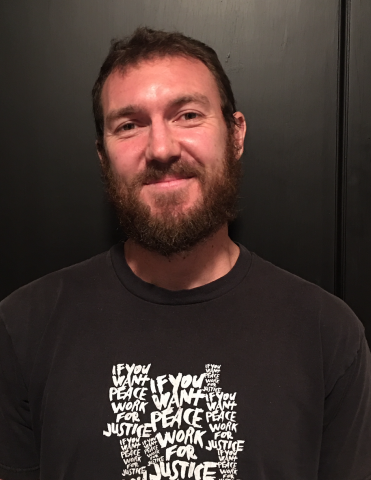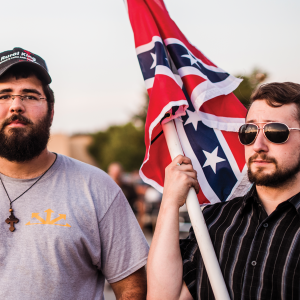
Eric Martin teaches religion at the University of California, Los Angeles, and is co-editor of The Berrigan Letters: Personal Correspondence Between Daniel and Philip Berrigan.
Posts By This Author
The Catholic Church Has a Visible White-Power Faction
Once persecuted by the Ku Klux Klan, some Catholics now embrace the most extreme forms of racial hatred.
WHEN THE U.S. Catholic bishops gathered to draft a document on race in the wake of the 2017 white terrorist rally in Charlottesville, Va., Bishop Anthony Taylor of Little Rock, Ark., submitted an amendment to condemn the imagery of swastikas, Confederate flags, and nooses. The U.S. bishops deliberated and voted to reject it.
The document, “Open Wide Our Hearts,” was billed as “a pastoral letter against racism,” making its writers’ inability to adopt the amendment condemning three famously extreme symbols of racism a curious one.The bishops explained themselves by arguing that swastikas and nooses were already “widely recognized signs of hatred,” which would seem to make them all the easier to condemn. (Interestingly, they eschewed this logic when issuing their only condemnation, against violence toward police.) As for the Confederate flag, “some still claim it as a sign of heritage,” they argued.
While this logic indefensibly hand-waves the history of slavery, murderous opposition to civil rights, and violence such as the 2015 shooting at a Black church in Charleston, S.C., as a vaguely benign “heritage,” it also fails to account for the flag’s use among those with no ties to the Confederacy. Take, for example, U.S. Rep. Steve King. While most widely known for asking what’s so wrong with white supremacy and white nationalism, King, who is Catholic, has also displayed a Confederate flag on his congressional desk. The quite obvious meaning of the flag’s presence on the desk of King, who represents a district in Iowa until January, is apparently lost on the bishops, given their claims about “Southern” heritage.
The decision to avoid condemning swastikas, nooses, and Confederate flags would be troubling under any circumstances. But this moral failure is compounded by the fact that Catholics are among the most integral groups that rally behind these symbols. From the highest reaches of government to the lowest depths of social media, many members of hate groups and politicians who model their talking points are part of the bishops’ flock. Catholics not only contributed to the platform for the so-called alt-righters who terrorized Charlottesville and killed Heather Heyer but are leaders and even founders of the most dangerous neo-Nazi groups in existence.
The Catholic Church, once persecuted by the Ku Klux Klan, today has a visible white-power faction. As long as the bishops actively refuse to condemn its banners, they give white supremacists space to embrace their anti-Black and anti-Semitic work free of religious dissonance.
An Image Beloved, A Prophet Rejected
This August will mark the 50th anniversary of Martin Luther King’s “I Have a Dream” speech, and there will rightly be much remembrance and celebration of its place in American history. But there is another anniversary that our nation, and especially its Christians, would do well to acknowledge, investigate, and ruminate.
Forty-five years ago yesterday, Dr. King arrived in Memphis, Tenn., to support a sanitation workers’ strike seeking to unionize. He was assassinated the next day — the anniversary we today remember — and in a sad irony our nation began the sanitation of his legacy. Indeed, King’s decision to join the Memphis struggle was just one of many acts that clash with what David Sirota calls the “Santa Clausified” image of King that we pass to our youth.

